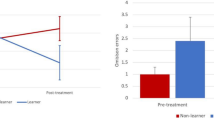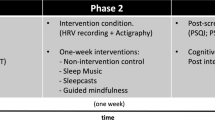Abstract
There is a growing interest in the application of psychophysiological signals in more applied settings. Unidirectional sensory motor rhythm-training (SMR) has demonstrated consistent effects on sleep. In this study the main aim was to analyze to what extent participants could gain voluntary control over sleep-related parameters and secondarily to assess possible influences of this training on sleep metrics. Bidirectional training of SMR as well as heart rate variability (HRV) was used to assess the feasibility of training these parameters as possible brain computer interfaces (BCI) signals, and assess effects normally associated with unidirectional SMR training such as the influence on objective and subjective sleep parameters. Participants (n = 26) received between 11 and 21 training sessions during 7 weeks in which they received feedback on their personalized threshold for either SMR or HRV activity, for both up- and down regulation. During a pre- and post-test a sleep log was kept and participants used a wrist actigraph. Participants were asked to take an afternoon nap on the first day at the testing facility. During napping, sleep spindles were assessed as well as self-reported sleep measures of the nap. Although the training demonstrated successful learning to increase and decrease SMR and HRV activity, no effects were found of bidirectional training on sleep spindles, actigraphy, sleep diaries, and self-reported sleep quality. As such it is concluded that bidirectional SMR and HRV training can be safely used as a BCI and participants were able to improve their control over physiological signals with bidirectional training, whereas the application of bidirectional SMR and HRV training did not lead to significant changes of sleep quality in this healthy population.



Similar content being viewed by others
Notes
Figure 2 show all 18 HRV–BFB and Fig. 3 all 21 SMR–NFB training sessions for the sake of completeness. As stated earlier, due to the operational setting of the military population, the number of completed trainings sessions varied between 11 and 21 per participant. Therefore, starting from training session 11 for the SMR-NFB and 13 for the HRV-BFB groups the bars and lines in Figs. 2 and 3 show average data assessed from a decreasing number of participants. Note, the number of completed training sessions were not different between the groups, t(24) = 1.38, p = .181. Next, in both Figs. 2 and 3 the average percentage of successful trials and achieved training level for down-regulation (effort; grey bars and red line, respectively) were converted into negative numbers to show the results for up- (relaxation) and down- (effort) regulation for both groups in only two Figures.
References
Ancoli, S., & Kamiya, J. (1978). Methodological issues in alpha biofeedback training. Biofeedback and Self-Regulation, 3, 155–183.
Ancoli-Israel, S., Cole, R., Alessi, C., Chambers, M., Moorcroft, M., & Pollak, C. P. (2003). The role of actigraphy in the study of sleep and circadian rhythms. Sleep, 26, 342–392.
Arns, M., de Ridder, S., Strehl, U., Breteler, M., & Coenen, A. (2009). Efficacy of neurofeedback treatment in ADHD: The effects on inattention, impulsivity and hyperactivity: A meta-analysis. Clinical EEG and Neuroscience, 40, 180–189.
Arns, M., Feddema, I., & Kenemans, J. L. (2014). Differential effects of theta/beta and SMR neurofeedback in ADHD on sleep onset latency. Frontiers in Human Neuroscience, 8, 1019.
Arns, M., Heinrich, H., Ros, T., Rothenberger, A., & Strehl, U. (2015). Editorial: Neurofeedback in ADHD. Frontiers in Human Neuroscience. https://doi.org/10.3389/fnhum.2015.00602.
Arns, M., & Kenemans, J. L. (2013). Neurofeedback in ADHD and insomnia: Vigilance stabilization through sleep spindles and circadian networks. Neuroscience and Biobehavioral Reviews, 44, 183–194.
Bianchi, G., & Sorrentino, R. (2007). Electronic filter simulation & design. New York: McGraw-Hill Professional, pp. 17–20.
Binsch, O., Banko, K., Veenstra, B. J., & Valk, P. J. L. (2015). Examining the relationship between mental, physical and organizational factors associated with attrition during maritime forces training. Journal of Strength & Conditioning Research, 29, 187–191.
Birbaumer, N., & Cohen, L. (2007). Brain-computer-interfaces (BCI): Communication and restoration of movement in paralysis. Journal of Physiology, 579, 621–636.
Birbaumer, N., Ghanayim, N., Hinterberger, T., Iversen, I., Kotchoubey, B., Kübler, A., et al. (1999). A spelling device for the paralysed. Nature, 398, 297–298.
Buysse, D. J., Reynolds, C. F. III, Monk, T. H., Berman, S. R., & Kupfer, D. J. (1989). The Pittsburgh Sleep Quality Index: A new instrument for psychiatric practice and research. Psychiatry Research, 28, 193–213. https://doi.org/10.1016/0165-1781(89)90047-4.
Cortoos, A., De Valck, E., Arns, M., Breteler, M. H., & Cluydts, R. (2010). An exploratory study on the effects of tele-neurofeedback and tele-biofeedback on objective and subjective sleep in patients with primary insomnia. Applied Psychophysiology and Biofeedback, 35, 125–134.
Del Pozo, J. M., Gevirtz, R. N., Scher, B., & Guarneria, E. (2004). Biofeedback treatment increases heart rate variability in patients with known coronary artery disease. American Heart Journal, 147, G1-G6.
Egner, T., & Gruzelier, J. H. (2001). Learned self-regulation of EEG frequency components affects attention and event-related brain potentials in humans. NeuroReport, 12, 4155–4159. https://doi.org/10.1097/00001756-200112210-00058.
Gruzelier, J. H. (2014). EEG-neurofeedback for optimising performance. In: A review of cognitive and affective outcome in healthy participants. Neuroscience and Biobehavioral Reviews, 44, 124–141.
Gruzelier, J. H., Egner, T., & Vernon, D. (2006). Validating the efficacy of neurofeedback for optimising performance. Progress in Brain Research, 159, 421–431.
Hammond, D. C. (2007). Neurofeedback for the enhancement of athletic performance and physical balance. The Journal of the American Board of Sport Psychology, 1, 1–9.
Hansen, A. L., Johnsen, B. H., & Thayer, J. F. (2009). Relationship between heart rate variability and cognitive function during threat of shock. Anxiety, Stress, & Coping, 22, 77–89. https://doi.org/10.1080/10615800802272251.
Hassett, A. L., Radvanski, D. C., Vaschillo, E. G., Vaschillo, B., Sigal, L. H., & Karavidas, M. K. (2007). A pilot study of heart rate variability (HRV) biofeedback in patients with fibromyalgia. Applied Psychophysiology and Biofeedback, 32, 1–10. https://doi.org/10.1007/s10484-006-9028-0.
Hoddes, E., Zarcone, V., Smythe, H., Philips, R., & Dement, W. C. (1973). Quantification of sleepiness: A new approach. Psychophysiology, 10, 431–436. https://doi.org/10.1111/j.1469-8986.1973.tb00801.x.
Hoedlmoser, K., Pecherstorfer, T., Gruber, G., Anderer, P., Doppelmayr, M., Klimesch, W., & Schabus, M. (2008). Instrumental conditioning of human sensorimotor rhythm (12–15 hz) and its impact on sleep as well as declarative learning. Sleep, 31, 1401–1408.
Kerkhof, G. A., Brouwer, A., Rijsman, R. M., Schimsheimer, R. J., & van Kasteel, V. (2013). Holland sleep disorders questionnaire: A new sleep disorders questionnaire based on the international classification of sleep disorders-2. Journal of Sleep Research, 22, 104–107. https://doi.org/10.1111/j.1365-2869.2012.01041.x.
Kinnear, P. R., & Gray, C. D. (2000). SPSS for Windows made simple. Hove: Psychology Press.
Kleinnijenhuis, M., Arns, M. W., Spronk, D. B., Breteler, M. H. M., & Duysens, J. E. J. (2008). Comparison of discrete-trial based SMR and SCP training and the interrelationship between SCP and SMR networks: Implications for brain-computer interfaces and neurofeedback. Journal of Neurotherapy, 11, 19–35.
Kober, S. E., Witte, M., Ninaus, M., Neuper, C., & Wood, G. (2013). Learning to modulate one’s own brain activity: The effect of spontaneous mental strategies. Frontiers in Human Neuroscience, 7, 695. doi:https://doi.org/10.3389/fnhum.2013.00695.
Lehrer, P. M., Vaschillo, E., & Vaschillo, B. (2000). Resonant frequency biofeedback training to increase cardiac variability: Rationale and manual for training. Applied Psychophysiology and Biofeedback, 25, 177–191. https://doi.org/10.1023/A:1009554825745.
Lehrer, P. M., Vaschillo, E., Vaschillo, B., Lu, S. E., Eckberg, D. L., Edelberg, R., Shih, W. J., Lin, Y., Kuusela, T. A., Tahvanainen, K. U., & Hamer, R. M. (2003). Heart rate variability biofeedback increases baroreflex gain and peak expiratory flow. Psychosomatic Medicine, 65, 796–805.
Lofthouse, N., Arnold, L. E., Hersch, S., Hurt, E., & DeBeus, R. (2012). A review of neu-rofeedback treatment for pediatric ADHD. Journal of Attention Disorders, 16, 351–372.
Meijman, T. F., Thunnissen, M. J., & De Vries-Griever, A. G. H. (1990). The after-effects of a prolonged period of day-sleep on subjective sleep quality. Work and Stress, 4, 65–70.
Monastra, V. J., Lynn, S., Linden, M., Lubar, J. F., Gruzelier, J., & LaVaque, T. J. (2005). Electroencephalograpic biofeedback in the treatment of attention-deficit/hyperactivity disorder. Applied Psychophysiology & Biofeedback, 30, 95–111.
Morin, C. M., LeBlance, M., Daley, M., Gregoire, J. P., & Merette, C. (2006). Epidemiology of insomnia: Prevalence, self-help treatments, consultations, and determinants of help-seeking behaviors. Sleep Medicine, 7, 123–130. https://doi.org/10.1016/j.sleep.2005.08.008.
Mulder-Hajonides van der Meulen W. R. E. H., Wijnberg, J. R., Hollanders, J. J., DeDiana, I., & Hoofdakker, R. (1980). Measurement of subjective sleep quality. Fifth European Congress on Sleep Research, Amsterdam.
Peterson, A. L., Goodie, M. J. L., Satterfield, W. A., & Brim, W. L. (2008). Sleep disturbance during military deployment. Military Medicine, 173, 230–235.
Piantoni, G., Poil, S.-S., Linkenkaer-Hansen, K., Verweij, I. M., Ramautar, J. R., Van Someren, E. J. W., & Van Der Werf, Y. D. (2013). Individual differences in white matter diffusion affect sleep oscillations. Journal of Neuroscience, 33, 227–233.
Royer, A.,S., Doud, A.,J., Rose, M.,L., & He, B. (2010). EEG control of a virtual helicopter in 3-dimensional space using intelligent control strategies. IEEE Transactions on Neural Systems and Rehabilitation Engineering, 18, 581–589.
Ruehland, W. R., O’Donoghue, F. J., Pierce, R. J., Thornton, A. T., Singh, P., Copland, J. M., Stevens, B., & Rochford, P. D. (2011). The 2007 AASM recommendations for EEG electrode placement in polysomnography: Impact on sleep and cortical arousal scoring. Sleep, 1, 34, 73–81.
Schabus, M., Heib, D. P. J., Lechinger, J., Griessenberger, H., Klimesch, W., Pawlizki, A., Kunz, A. B., Sterman, B. M., & Hoedlmoser, K. (2014). Enhancing sleep quality and memory in insomnia using instrumental sensorimotor rhythm conditioning. Biological Psychology, 95, 126–134.
Spronk, D., Kleinnijenhuis, M., Luijtelaar, G., & Arns, M. (2010). Discrete-trial SCP and GSR training and the interrelationship between central and peripheral arousal. Journal of Neurotherapy, 14, 217–228.
Sterman, M. B. (2000). Basic concepts and clinical findings in the treatment of seizure disorders with EEG operant conditioning. Clinical EEG (Electroencephalography), 31, 45–55.
Sterman, M. B., & Egner, T. (2006). Foundation and practice of neurofeedback for the treatment of epilepsy. Applied Psychophysiology and Biofeedback, 31, 21–35.
Sterman, M. B., Wyrwicka, W., & Roth, S. R. (1969). Electrophysiological correlates andneural substrates of alimentary behaviour in the cat. Annals of the New York Academy of Science, 157, 723–739.
Tan, G., Thornby, J., Hammond, D. C., Strehl, U., Canady, B., Arnemann, K., & Kaiser, D. A. (2009). Meta-analysis of EEG biofeedback in treating epilepsy. Clinical EEG and Neuroscience, 40, 173–173.
Vernon, D., Dempster, T., Bazanova, O., Rutterford, N., Pasqualini, M., & Andersen, S. (2009). Alpha neurofeedback training for performance enhancement: Reviewing the methodology. Journal of Neurotherapy, 13, 214–227.
Vernon, D., Egner, T., Cooper, N., Compton, T., Neilands, C., Sheri, A., & Gruzelier, J. (2003). The effect of training distinct neurofeedback protocols onaspects of cognitive performance. International Journal of Psychophysiology, 47, 75–86.
Wolpaw, J. R., & McFarland, D. J. (2004). Control of a two-dimensional movement signal by a noninvasive brain-computer interface in humans. Proceedings of the National Academy of Sciences of the U. S. A. 101, 17849–17854.
Yuan, H., & He, B. (2014). Brain-computer interfaces using sensorimotor rhythms: Current state and future perspectives. IEEE Transactions on Biomedical Engineering, 61, 1425–1435.
Zucker, T. L., Samuelson, K. W., Muench, F., Greenberg, M. A., & Gevirtz, R. N. (2009). The effects of respiratory sinus arrhythmia biofeedback on heart rate variability and posttraumatic stress disorder symptoms: A pilot study. Applied Psychophysiology & Biofeedback, 34, 135–143.
Author information
Authors and Affiliations
Corresponding author
Ethics declarations
Conflict of interest
The authors declare that they have no conflict of interest.
Ethical Approval
All procedures performed in studies involving human participants were in accordance with the ethical standards of the institutional research committee and with the 1964 Helsinki declaration and its later amendments or comparable ethical standards.
Informed Consent
Informed consent was obtained from all individual participants included in the study.
Rights and permissions
About this article
Cite this article
Binsch, O., Wilschut, E.S., Arns, M. et al. No Effects of Successful Bidirectional SMR Feedback Training on Objective and Subjective Sleep in Healthy Subjects. Appl Psychophysiol Biofeedback 43, 37–47 (2018). https://doi.org/10.1007/s10484-017-9384-y
Published:
Issue Date:
DOI: https://doi.org/10.1007/s10484-017-9384-y




